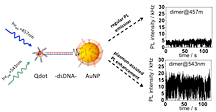- Number 318 |
- August 16, 2010
Nanoparticles increase quantum dots’ glow
Photoluminescence enhancement is
demonstrated at the single molecule
level for two-particle systems
composed of a quantum dot (Qdot
) and gold nanoparticle (AuNP)
linked by double stranded DNA
(dsDNA) when optically excited with
wavelengths within the surface
plasmon resonance range of the
gold nanoparticle. (Click image for
larger size.)
By linking individual semiconductor quantum dots with gold nanoparticles, scientists at DOE's Brookhaven Lab have demonstrated the ability to enhance the intensity of light emitted by individual quantum dots by up to 20 times. The precision method for making the light-emitting particle clusters will greatly advance scientists’ ability to study and modify the optical properties of quantum dots, and could eventually lead to improved solar energy conversion devices, light-controlled electronics, and biosensors.
The team at Brookhaven’s Center for Functional Nanomaterials used short strands of DNA as highly specific “glue” to link individual semiconductive quantum dots with gold nanoparticles. Metallic materials are known to affect the optical properties of quantum dots, either by enhancing or inhibiting photoluminescence, depending on a range of factors including the size and shape of the materials, the distance between them, and the wavelength of light used to induce photoexcitation. The DNA-based assembly technique allowed the scientists to control the size, shape, and distance factors to a high degree of precision and test the effect of wavelength in isolation, leading to the identification of a wavelength that enhanced photoluminescence by an order of magnitude.
This ability to control the properties of quantum dots will be essential to the development of devices such as solar cells, light emitting diodes, or optical circuits and might improve the sensitivity of quantum-dot based biosensing assays.
Whole story: http://www.bnl.gov/bnlweb/pubaf/pr/PR_display.asp?prID=1157
[Karen McNulty Walsh, 631 344-8350,
kmcnulty@bnl.gov]

